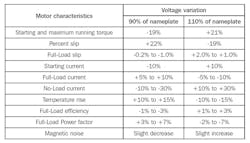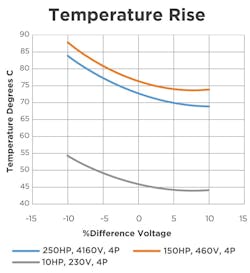When an electric motor experiences performance problems or fails prematurely, the cause can frequently be traced to an incorrect voltage specification. Avoiding these errors is easy if one simple rule is followed: Rated motor voltage should be slightly lower than rated transformer (distribution) voltage.
It is essential to understand the difference between motor voltage and transformer voltage. Transformer, or “distribution,” voltage is delivered by electric utilities for distribution to equipment. Motor, or “utilization” voltage, is measured at the motor terminals. Because of the voltage drop from the transformer to the motor, the operating motor “utilization” voltage should be slightly lower than the rated “distribution” voltage supplied by the utility (see Figure 1).
Figure 1. Voltage is stepped down as it moves through the electric grid.
A history lesson
Prior to 1965, the National Electrical Manufacturers Association (NEMA) recommended nominal motor nameplate voltages of 110, 208, 220, 440 and 550 volts (V), which are approximately 10 percent below standard distribution voltage. However, in the last 50 years most standards called for ratings of 115, 208, 230, 460 and 575V, representing a 5 percent drop from distribution voltages. These changes were made to accommodate updated application practices and a more stringent distribution system. Also, as defined by ANSI C84.1, utilities can supply slightly higher voltage to accommodate longer distribution runs and higher line loads.
Two major motor voltage standards are defined by separate agencies and used worldwide. They are NEMA in North America and International Electrotechnical Commission (IEC) in most other countries. Both standards agree that rated motor voltage should always be less than the rated distribution voltage. It is important to understand the differences in agency requirements as they relate to the region in which the motor will be installed. For example, in some European countries, as well as in the Middle East and Asia, IEC standards apply. It is imperative, when specifying electric motor voltage, to understand each region’s standards and requirements on voltage drop to avoid undue electrical system stress and premature system failures.
Voltage & electric motor performance
Electricity is distributed through power lines to the end user at 10,000 volts or higher. Utilities rarely know how the power they generate will be used, so transformers located throughout the power distribution system are used to reduce the voltage to the industrial and residential levels needed by end users.
Once the voltage is lowered, for example to 4,160 volts, the power enters a substation and is dropped again to 2,400, 480 or 240 volts, a level at which commercial and industrial facilities can operate cooling towers, pumps and other equipment.
Electricity destined for residential use is distributed through pole-mounted transformers which then reduce voltage to the 240 volts necessary to power common household electrical devices.
On appliance labels or the labels on other motor-driven equipment, the rated voltage never equals 240 volts but is rather specified as 230 volts. In a commercial or industrial setting, three-phase motors are often rated at 460 or 2,300 volts rather than the 480 or 2,400 volts of the electricity that typically enters a plant. The lower voltage rating on the motor considers the voltage drop that occurs because of the impedance of the circuit connecting the transformer and the driven equipment. The National Electrical Code (NEC) recommends a voltage drop of less than 5 percent for the combined branch circuit and feeder lines. For example, a 480V transformer should provide no less than 456V to the equipment using the voltage. All international electric motor standards address voltage drops and would therefore specify 460V as an appropriately rated motor voltage.
A motor running at its nominal voltage should experience normal life expectancy and is more efficient to operate. NEMA recommends that electric motors built for commercial and industrial use are designed to operate at voltages slightly lower than the supply voltages. In fact, NEMA recommends approximately a 5 percent drop from the transformer voltage to the motor voltage (see Table 1).
Table 1. For three-phase AC machines that are 50 Hz or 60Hz intended to be directly connected to distribution or utilization systems, the rated voltages should be selected from the voltages given here. Other voltages are subject to approval between the manufacturer and purchaser.
The highs & lows of electric motor voltage
Motor damage can occur when the utilization voltage is significantly different than the voltage for which a device is rated. Overvoltage is a condition that, per the listed standards, begins with a voltage 10 percent above the rated motor voltage. Higher output or efficiency cannot be achieved by supplying a higher than nominal voltage to the motor. The motor will convert this extra energy into heat instead of usable output such as torque. The heat accelerates the degradation of the insulation and bearing systems.
While overvoltage can degrade equipment, constant undervoltage does more harm and greatly impacts equipment performance and reliability. To drive a load, a motor must have enough power to overcome the torque required by that load. Motor power is calculated by voltage x current, otherwise known as Ohm’s Law. So if voltage drops, the current must increase to maintain enough power to transfer the required torque to the driven load. This increase in current causes excess heat to be generated which, over time, can lead to premature motor failure like that seen in overvoltage. A good rule of thumb, per NEMA, is that for every 10-degree rise in motor temperature, motor life is reduced by half.
Table 2. General effect of voltage variations on characteristics of induction motors
Table 2 and Figure 2 illustrate a voltage variation analysis conducted on three common induction motor ratings. It shows that a temperature increase of approximately 10 degrees correlates to a 10 percent difference from the rated voltage.
In other words, a 10 percent voltage drop reduces the motor life by half.
Because of the natural voltage loss, or sag, that occurs during transmission, undervoltage occurs more often than overvoltage. Therefore, it is important to use the international standards that already take voltage losses into account to specify and design electric motors.
Figure 2. Temperature rise
The bottom line on voltage
Electric motors are designed to operate within a voltage range that is typically +/-10 percent of rated voltage to accommodate normal swings in distribution voltage. Continuous operation at either the high or low end will shorten the life of the motor. Therefore, when specifying voltage ratings, never match the electric motor voltage rating to a facility’s transformer rating. Always specify a motor voltage that is approximately 5 percent below the transformer voltage. Doing so will save energy, increase motor performance and protect the equipment’s useful life.
Jeff Farris is an electrical design engineer and Patrick Hogg is manager of application engineering for Nidec Motor Corporation. For more information on voltage selection and its impact on motor safety and performance, consult NEMA Standards Publication MG 1-2011 or Nidec Motor Corporation.






